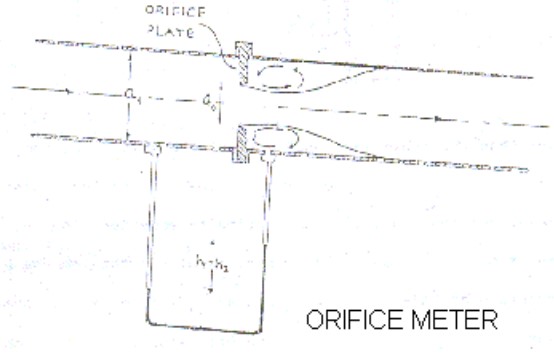To calibrate orifice meter by establishing the relationship between flowrate and pressure difference and to find its coefficient of discharge.
EquipementVenturi meter and orifice meter fitted in a horizontal pipeline with means of varying flow rate, U tube differential manometer.
Introduction and theory:The venturi meter and orifice meter are devices used for measurement of rate of flow of fluid through a pipe. The basis principle on which orifice meter work is that by reducing the cross sectional area of flow passage, a pressure difference is created and the measurement of the pressure difference enables the determination of the discharge through the pipe.
Orificemeter:An orifice meter is a cheap arrangement for measurement of discharge through pipes and its installation requires a smaller length as compared with venturi meter.

An orifice meter consists of a flat circular plate with a circular hole called orifice which is concentric with the pipe axis. The upstream face of the plate is beveled at an angle lying between 30 and 45. The plate is clamped between the two pipe flanges with beveled surface facing downstream. The pressure taps are provided, one on the upstream side of plate and other on the downstream side of the orifice plate. A pressure difference exist between two sections which can be measured by connecting a differential manometer to the two pressure taps. The discharge coefficient can be calculated using formula
Q = Ca0a√2g Δh1/√a21-a21-a20
where C is coefficient of orifice, a is cross section area of orificde, a is cross sectional area of pipe, g is the acceleration due to the gravity and Δh is the difference of head in terms of water.
Experimental Set Up:The experimental set up consist of a circuit, through which the fluid is circulated continuously having a an orifice meter, of 25mm dia and having d/D = .6. A regulating value is provided on the downstream side of the circuit to regulate the flow. The orifice meter also have two pressure tapings at upstream and downstream. A U tube differential manometer with common manifold is provided to measure the pressure difference between two sections. A collecting tank is used to find the actual discharge through the circuit.
Experimental procedure:Note down the relevant dimensions as diameter of pipeline, throat dia of orifice. Area of collecting tank, room temperature etc.
Pressure tapings of orifice meter are open, while of venturimeter (discussed in the next experiment) are closed.
The flow rate was adjusted to its maximum value.
By maintaining suitable amount of steady flow in the pipe circuit, there establishes a steady non uniform flow in the conduit. Time is allowed to stabilize the levels in the manometer tube.
The discharge flowing in the circuit is recorded together with the water level in left and right limbs of manometer tube. The flow rate is reduced in stages by means of flow control valve and the discharge and readings of manometer are recorded.
This procedure is repeated by closing the pressure tapings of orifice meter.
Observation and computation sheet.
Diameter of main pipe line D = 25mm
The ratio d/D = 0.
Area of cross section of throat section, a0= , d = 15mm
Area of cross section of inlet section , a1 =
Area of collecting tank
| Sr. No. | Discharge Measurement/Initial (cm)/Final(cm)/Time(s)Discharge, Q (cm3/s) | /Velocity, Q/A | Manometer Reading/Left Limb, h1(cm)/Right Limb, h2(cm)/Diff. of head in terms of water,Δh = 12.6(h1-h2) | C = Q√a21-a20/ a0a1√2gh | Reynolds Number Re (DVrho/mu) |
Average C
Graph to plot :





Get all latest content delivered to your email a few times a month.